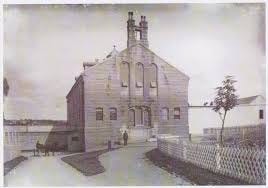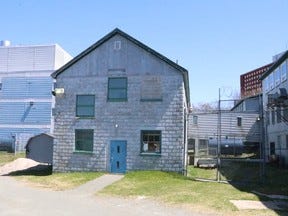Her Majesty’s Penitentiary: Part 1: The Stone Cage by the Lake

Where it all began: the first courthouse and jail in St. John’s, built in the 1730s under Governor Henry Osborne
If you’ve ever strolled along Quidi Vidi Lake in St. John’s, you’ve likely passed it. A gray beast of stone and wire. It doesn’t shout at you—it waits. Quietly. Decaying in plain sight.
This is Her Majesty’s Penitentiary, known by locals as HMP. But this isn’t just a prison—it’s a character. A monster. A relic that has watched Newfoundland grow from colony to province while keeping its secrets locked behind rusted bars and crumbling concrete.
This is Part 1 of a three-part deep dive into one of the oldest prisons in Canada still in operation. We’ll begin at the beginning—with the dreams, disasters, and disturbing birth of HMP.
Pre-HMP: Law Without Order (1730s–1850s)
Before there was a penitentiary, there were makeshift jails, more symbolic than secure. Justice in colonial Newfoundland wasn’t built to last—literally.
1730s: The first courthouse and jail in St. John’s was constructed on Duckworth Street, a wooden structure under Governor Henry Osborne.
Early 1800s: A sturdier stone courthouse and jail replaced it. But fate had other plans.
1846: The Great Fire tore through St. John’s, burning the courthouse to the ground. The city had lost its only formal prison.
From 1846 to 1859, Signal Hill became a temporary holding ground. Inmates were locked inside military barracks—cold, dark, and poorly ventilated. There was no sanitation, no system of reform, and no dignity.
Just slop buckets, illness, and the wind howling through the cracks.
The Big Idea: A Modern Penitentiary for a Colony on the Edge
In 1852, the colonial government decided to do what they should have done decades earlier—build a real penitentiary. Not just a jail, but a purpose-built institution meant to reform, not just punish.
They hired R.D. Hill, a British architect from Birmingham, and asked him to create a prison inspired by London’s infamous Pentonville model. What he came up with was… ambitious:
A T-shaped stone structure
Three stories, plus attic and basement
62 individual cells, including 6 for debtors and a small number for women
Rooms for work, prayer, laundry, cooking, administration, and more
It was to be maximum security and “spacious” by 1850s standards. A symbol of progress.
But then Newfoundland did a very Newfoundland thing: it ran out of money.
In 1855, when the island achieved responsible government, the new administration hit a financial wall. Construction stopped with only a basement completed. For years, the partially built penitentiary stood like a half-buried tombstone.
Then, in 1858, the project was scaled down and resumed. On August 29, 1859, Her Majesty’s Penitentiary officially opened. Unfinished. Unrefined. And already flawed.
Keep reading with a 7-day free trial
Subscribe to The Newfoundland History Sleuth to keep reading this post and get 7 days of free access to the full post archives.





